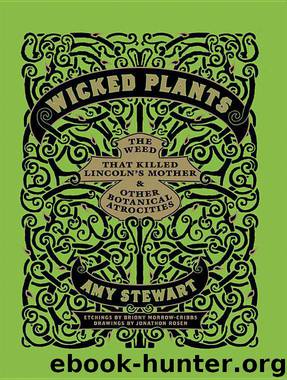Wicked Plants: The Weed That Killed Lincoln's Mother and Other Botanical Atrocities by Amy Stewart & Briony Morrow-Cribbs

Author:Amy Stewart & Briony Morrow-Cribbs
Language: eng
Format: mobi
ISBN: 9781565126831
Publisher: Algonquin Books
Published: 2009-05-21T06:00:00+00:00
Meet the Relatives Hops (Humulus lupulus), used to flavor beer, are in the same family as cannabis. They have no known intoxicating qualities, although the buds may act as a mild sedative. The hackberry (Celtis spp.) is a related genus of North American ornamental trees.
DEADLY
Oleander
NERIUM OLEANDER
In AD 77 Pliny the Elder described the oleander as “an evergreen, bearing a strong resemblance to the rose-tree, and throwing out numerous branches from the stem; to beasts of burden, goats, and sheep it is poisonous, but for man it is an antidote against the venom of serpents.”
FAMILY:
Apocynaceae
HABITAT:
Tropical, subtropical, and ternperate climates, usually in dry, sunny locations and dry streambeds
NATIVE TO:
Mediterranean areas
COMMON NAMES:
Rose laurel, be-still tree
Pliny may have been the most influential botanist of his time, but he was wrong about the oleander. The only relief it would provide a snakebite victim would be a swift and merciful death. This highly toxic shrub is popular in warm climates around the world for its red, pink, yellow, or white blossoms. Because it is so widespread, it has been implicated in a surprising number of murders and accidental deaths over the years. One popular legend is that campers have died after grilling meat over the campfire on skewers made from oleander twigs. This tale is unconfirmed, but the poisons in the sap and bark of oleander could easily contaminate food.
Oleander contains oleandrin, a cardiac glycoside that brings on nausea and vomiting, severe weakness, irregular pulse, and a decreased heart rate that leads quickly to death. It is also toxic to animals: in spite of the leaves’ bitter taste, a cat or dog might be tempted to nibble them. Inhaling the smoke from burning oleander wood can be highly irritating, and even honey made from the plant’s nectar can be poisonous. A study of compost made from oleander showed that oleandrin remains in the compost at detectable levels for three hundred days but that vegetables grown in the compost don’t absorb the toxins.
A woman in Southern California tried to collect on her husband’s life insurance by putting oleander leaves in his food.
Children are particularly at risk because it takes only a few leaves to kill them. In 2000 two toddlers in Southern California were found dead in their cribs after chewing on the leaves. Just a few months later, a woman in Southern California tried to collect on her husband’s life insurance by putting the leaves in his food. He went to the hospital with severe gastrointestinal problems, but he survived. As he was recuperating, his wife finished the job by offering him Gatorade laced with antifreeze. She is now one of fifteen women on California’s death row, and the only one who attempted murder with a plant.
Oleander-related suicide attempts turn up regularly in medical literature; particularly among nursing-home patients, probably because the plant is popular in landscapes and is well known among elderly people as a poisonous plant. In Sri Lanka a related plant called the yellow oleander (Thevetia peruviana) has become the most common method of suicide, particularly among women.
Download
This site does not store any files on its server. We only index and link to content provided by other sites. Please contact the content providers to delete copyright contents if any and email us, we'll remove relevant links or contents immediately.
Turbulence by E. J. Noyes(7942)
The Thirst by Nesbo Jo(6832)
Gerald's Game by Stephen King(4584)
Be in a Treehouse by Pete Nelson(3954)
Marijuana Grower's Handbook by Ed Rosenthal(3623)
The Sprouting Book by Ann Wigmore(3546)
The Red Files by Lee Winter(3368)
The Remains of the Day by Kazuo Ishiguro(3296)
Sharp Objects: A Novel by Gillian Flynn(2958)
Christian (The Protectors Book 1) by L. Ann Marie(2656)
Organic Mushroom Farming and Mycoremediation by Tradd Cotter(2631)
The Culinary Herbal by Susan Belsinger(2433)
Stone Building by Kevin Gardner(2353)
The Starter Garden Handbook by Alice Mary Alvrez(2285)
Lilac Girls by Martha Hall Kelly(2258)
The Unlikely Pilgrimage of Harold Fry by Rachel Joyce(2222)
The Lean Farm Guide to Growing Vegetables: More In-Depth Lean Techniques for Efficient Organic Production by Ben Hartman(2099)
Urban Farming by Thomas Fox(2063)
Backyard Woodland by Josh VanBrakle(1896)
